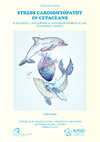Please use this identifier to cite or link to this item:
https://accedacris.ulpgc.es/jspui/handle/10553/76688
| Title: | Stress Cardiomyoapathy In Cetaceans: Histological, Histochemical, Immunohistochemical And Biochemical Studies | Authors: | Câmara, Nakita | Director: | Herráez Thomas, Pedro Manuel Sierra Pulpillo, Eva María |
UNESCO Clasification: | 310907 Patología 240119 Zoología marina |
Keywords: | Takotsubo Cardiomyopathy Cardiac Troponin Capture Myopathy Beluga whales Tako-Tsubo, et al |
Issue Date: | 2020 | Abstract: | Previous studies have shown the susceptibility of cetaceans to stress through blood tests that demonstrate the activation of the hypothalamic-pituitary-adrenal axis with the consequent production and release of glucocorticoids, mineralocorticoids and catecholamines (adrenaline and norepinephrine) (Prosser 1986; Spraker 1993). Although the beneficial effects of stress system activation are well known, in extreme or prolonged situations, animals can be adversely affected by the effects of physical and psychological stress (Cowan and Curry 2002). Therefore, marine mammals can develop extreme responses to stress that cause a significant deterioration in animal health and even death. Cardiac lesions seem to play a central role in these adverse responses to stress in cetaceans. Different authors suggest that these animals are particularly predisposed to develop stress cardiomyopathy (SCMP) probably due to the characteristics of their cardiovascular adaptations, conforming to the requirements of diving metabolism (Cowan and Curry 2002; Cowan et al. 2000; Cozzi et al. 2017; Herráez et al. 2007, 2013). In recent decades, efforts have been made to reduce the impact that some human activities have on free-living cetaceans, but unfortunately whales and dolphins continue to be threatened by: active (live) stranding and interactions with humans, collision with ships and accidental capture (bycatch). These different pathological entities have acute stress, as the centre of its etiopathogenesis, which can cause the death of the animal or seriously aggravate a previous disease situation, while influencing its subsequent rehabilitation, making the therapy and recovery of the animals involved not successful (Arbelo et al. 2013; Bonsembiante et al. 2017; Cowan and Curry 2008; Díaz-Delgado et al. 2018; Duignan and Jones 2005; Gulland et al. 2018; Herráez et al. 2007, 2013; Sierra et al. 2014, 2017; Soulsbury et al. 2008). The investigation here presented was designed with the aim of continuing the research in cetaceans, with a double intention: - On the one hand, characterize cardiomyopathy due to stress in cetaceans, trying to provide greater knowledge about their pathologies derived from a situation of acute stress. - On the other hand, this knowledge would help us find applicable solutions, using health as a necessary instrument for the conservation of cetaceans in our seas. Thus, based on the above, this will be achieved through specific objectives such as: 1. Characterize SCMP, as injuries resulting from extreme stress responses in live-stranded cetaceans subjected to capture and interaction with humans, as well as in dead cetaceans due to ship strikes and interactions with fisheries (bycatch). 2. Correlate the blood values detected for the biochemical markers of acute cardiac muscle damage with the pathological findings identified histologically, in actively stranded cetaceans and subjected to capture and interaction with humans. 3. Application of the knowledge obtained previously in the diagnosis of specific clinical cases. This thesis is presented as the compendium of four articles, published in peer-review journals with high scientific impact, describing the results and interpretation of the biochemical, histological, histochemical and immunohistochemical analysis conducted. This study represents the first biochemical and morphological characterization of SCMP, as an injury resulting from extreme stress response in live-stranded cetaceans and subjected to capture and interaction with humans, dead cetaceans due to collisions with ships and with fishing activities interaction (bycatch). | Description: | Programa de Doctorado en Sanidad Animal y Seguridad Alimentaria por la Universidad de Las Palmas de Gran Canaria | Institute: | IU de Sanidad Animal y Seguridad Alimentaria | URI: | https://accedacris.ulpgc.es/handle/10553/76688 |
| Appears in Collections: | Tesis doctoral |
Page view(s)
667
checked on Oct 25, 2025
Download(s)
997
checked on Oct 25, 2025
Google ScholarTM
Check
Share
Export metadata
Items in accedaCRIS are protected by copyright, with all rights reserved, unless otherwise indicated.
